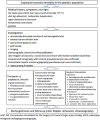Severe Blunt Liver Injury Complicated by Delayed Massive Hemobilia in a Toddler: A Case Report and Literature Review
- PMID: 35874128
- PMCID: PMC9304685
- DOI: 10.3389/fsurg.2022.930581
Severe Blunt Liver Injury Complicated by Delayed Massive Hemobilia in a Toddler: A Case Report and Literature Review
Abstract
Introduction: Unintentional injuries remain a leading cause of disability among children. Although most of the pediatric patients suffering blunt liver injury can be successfully treated with non-operative therapy, the diagnosis and management of delayed life-threatening hemobilia following severe blunt liver injury, especially in the pediatric population, remain a challenge for clinicians.
Case presentation: A previously healthy 2-year-old girl suffered a severe blunt liver injury related to an electric bike, which was inadvertently activated by herself. She initially received non-operative therapy and was in a stable condition in the first 2 weeks. On the 16th and 22nd postinjury days, the patient presented with life-threatening massive hemobilia, which was confirmed via repeat emergent gastroscopy and hepatic arterial angiography. An emergency selective transarterial embolization of the involved branch of the left hepatic artery was successfully performed. The patient recovered uneventfully, and long-term follow-up was needed owing to a mild dilatation of the left intrahepatic bile duct.
Discussion: Incidental injury in children should be considered as a major public health issue and preventive measures should be taken to reduce its occurrence. Delayed massive hemobilia after severe blunt liver trauma is rare, and its accurate and timely diagnosis via emergency hepatic arterial angiography and selective angioembolization may allow prompt and optimal management to achieve good outcomes in the pediatric population.
Keywords: blunt hepatic trauma; case report; delayed massive hemobilia; injury prevention; toddler.
Copyright © 2022 Liu, Sun, Sun, Niu, Wang, Liu, Fu, Geng and Li.
Conflict of interest statement
The authors declare that the research was conducted in the absence of any commercial or financial relationships that could be construed as a potential conflict of interest.
Figures



References
-
- Peden M, Oyegbite K, Ozanne-Smith J, Hyder AA, Branche C, Rahman AKMF, et al. World report on child injury prevention. Geneva: World Health Organization; (2008). - PubMed
-
- Zhou X. The choice of core control algorithm for 2-wheeled auto-balancing electric vehicle. Office Automation. (2013) 4:56–7 (in Chinese). CNKI:SUN:BGDH.0.2013-08-020
Publication types
LinkOut - more resources
Full Text Sources

